Palms & Cycads for the Midsouth Landscape
What Is a Palm?
For the purposes of this publication, a palm is a plant that is in the Arecaceae or Palmae plant family. They are monocots (like grasses), and they are the true palms (Figure 1; see figures on pages 8 to 13). There are more than 200 genera and around 2,600 species of palms that occur in tropical to warm-temperate parts of the world (Figure 2). Some species are rare (Figure 3), and at least 100 species are endangered. It is believed that nine species have recently become extinct. There is only one plant remaining of the rarest palm. However, other species are extremely common, like the coconut palm (Figure 4).
Palms occur in both hemispheres and from wet to dry habitats, seashore to inland, lowlands to mountains. Some palm species are native to Mississippi (Figure 5), and a number of exotic species are found in cultivation. Palms are perennial plants, although some are monocarpic (flower only once and then die). Palms may be shrubs, trees, or vines depending upon the species. Most palms in cultivation are either shrubs or trees.
Palms have two leaf types (Figure 6): pinnate, with leaves that tend to be long with pinnate leaflet arrangement, and palmate, with leaves that are more or less palm- or hand-like in shape. Palms may have single (monopodial) or multiple (sympodial) trunks (Figure 7) and vary in height from very short to very tall. Multiple trunking may also be referred to as suckering or clumping. This feature is included in the comments sections of Tables 1 and 2.
Humans have used palms for more than 5,000 years. In addition to their landscape value, palms can be a source of food, drink, medicine, construction materials, oil (Figure 8), and wax. Coconuts (Figure 9) and true dates (Figure 10) come from palms. Rattan used in furniture comes from palms. For these reasons—and, typically, unlike cycads—palms may have more than ornamental uses within the landscape.
What Is a Cycad?
A number of other plants are also called “palms.” These include plants like sago palm (Cycas revoluta) (Figure 11), ponytail palm (Beaucarnea recurvata), traveler palm (Ravenala madagascarensis) (Figure 12), and Madagascar palm (Pachypodium lamarei). Although none of these are true palms, the cycads, which are primarily in the Cycadaceae and Zamiaceae families, have landscape uses similar to true palms, so they are included in this publication.
Cycads are gymnosperms, so they are more closely related to pines (Pinus spp.) than to true palms. They produce cone-like structures with seeds between the scales. This group of plants is considered to be very old, with fossil records dating to 280 million years ago and believed to predate even dinosaurs. Many species are now extinct, and some species are very rare and only exist in cultivation or small, wild populations. There are more than 300 species of cycads worldwide. They typically are not as cold-tolerant as palms, and many occur in very dry climates. Most cycads are slower-growing, smaller, less common, and more expensive than palms. They have pinnate leaves, which are often stiff with sharp margins (Figure 13). Still, they can add a very interesting feature to the landscape and are commonly cultivated in warm southern or tropical landscapes (Figure 14). Since they often have drought tolerance, they provide a unique feature to dry landscapes.
As with true palms, people have many uses for cycads. They, too, have been used for food and other things for many years. However, most cycads are poisonous. For this and other reasons, true palms generally have a wider range of landscape uses compared to cycads, which tend to be used only as ornamentals.
Selecting Palms and Cycads
Selecting the appropriate species of palm or cycad for your home landscape will add to the beauty and enjoyment of your property. Use the information in Tables 1 and 2 when making your decision. Base your selection on plant zone, space limitations, function, available sunlight, soil type, desired effect, and other factors. For example, if you want to emphasize the entrance to your driveway, placing a single, large cycad on either side of the driveway entrance, as in the drawing below, would certainly draw attention and add interest and drama (Figure 15).
There are many different palms and cycads from which to choose. Palms can range from well over 100 feet in height and 30 feet in spread to just a few feet in height and spread. Foliage form can be long, feathery, or solid, or even shaped like a fishtail (Figure 16). Foliage color could range from pale gray-green to blue-green or medium green (Figure 17). Some have colorful leaf petioles (Figure 18). Trunks can vary in color from white-gray to brown and every shade in between. The trunks also exhibit interesting textures and shapes (Figure 19). Cycads for the Midsouth range from approximately 3 to 25 feet in height and from 3 to 10 feet in spread. Foliage has a very coarse texture and bold appearance in the landscape. As the cycad grows, a very attractive trunk is visible, which adds another landscape feature (Figure 20).
Many of these species will live for many years, so keep in mind that this can be a long-term decision. Because palms and cycads can change form as they grow—starting out shrub-like and becoming more tree-like later—you should consider the proper placement of these plants in the landscape. Choose plants that will be pleasing for a long time and that will be in scale with the surroundings (Figures 21 and 22). Picture the plant up until maturity so you can get an idea of how it will function long-term in the landscape. A web search of the species may provide images that can help you make this decision.
Conducting a site evaluation before making a plant selection will ensure that you choose the best palm or cycad for your landscape conditions. One of the most important landscape performance aspects is cold hardiness.
Cold Hardiness
Although many species of palms and cycads have some degree of cold hardiness, most are not very cold hardy. However, more information about palm and cycad hardiness continues to be discovered, so additional species probably will be available commercially for Midsouth landscapes in the future. Keep in mind that cold tolerance may be the most important environmental factor when choosing palms and cycads for
the landscape.
As a reminder, even though a species has cold tolerance, it will likely do better without cold temperatures. This is important to remember if there is a choice between leaving a plant outside in a container or moving the container inside for the winter. In addition, if there is a choice between two species with similar landscape effect, choose the one with the best cold tolerance. For example, if you live in zone 8a and you have a choice between an 8a- or 7b-hardy species with similar landscape effect, choose the species that is hardy to 7b. This may help with future planning, as well, since cold weather is unpredictable 2 or more years in the future.
It is important to remember that other environmental factors affect cold hardiness. For example, air and soil moisture, as well as the length of the cold period, are important factors. Some species do better with either dry or moist cold. In addition, short cold periods are generally easier for plants to survive than long cold periods, even if temperatures are the same. Wind can also affect cold damage. Cold wind can both desiccate and freeze foliage. Some protection from cold winds can often prevent foliar damage.
Frost is another factor to consider. Frost can occur without freezing and may damage plants. Covering plants when temperatures are very low can keep frost from damaging plants. Keep in mind that certain areas are more prone to frost than others. For example, valleys or low areas may receive frost more than higher locations.
Another consideration with cold hardiness is landscape location. North sides of structures tend to be colder than south sides. It may not seem significant, but a few degrees can make the difference between survival and death, or between no foliar damage and severe foliar damage. Remember that south sides also tend to be hotter in summer months.
Winter protection is important for cold-sensitive species. You can address this, in part, by covering plant bases and roots with mulch or other materials. You may need to cover plants with poly film (plastic), blankets, or other materials during more severe periods, depending on the hardiness of the species. Therefore, monitoring weather forecasts is important for the survival of some species during weather extremes. It may be too late after the freeze.
Plants in pots are especially vulnerable to extended cold periods. Be prepared to move potted plants indoors if weather conditions warrant. Larger pots can be placed on coasters or platforms with wheels for easier movement. You may use a cart to move large plants. Keep in mind that potted plants may also need water during winter months, even if rainfall seems adequate. Check soil moisture regularly to make sure plants do not become desiccated. Desiccation may look similar to cold damage.
Lastly, keep cost in mind. Many species of palms, and particularly cycads, are very expensive. In fact, cycad seedlings can cost as much as $200 per plant. In addition, some species are difficult to find commercially. So don’t take unnecessary chances with plant materials during cold weather. If in doubt, use caution. If you think your palm or cycad has experienced cold damage, refer to MSU Extension Information Sheet 1663 The Plant Doctor: Cold Injury.
Conservation Matters
A number of palm and cycad species are very rare in their native country or countries. Many are mentioned in the comments column of Tables 1 and 2 of this publication. More information about the protection status of a particular species can be found at the International Union for Conservation of Nature website or other websites. When ordering online, remember that some species are regulated by international law and may not be shipped into the United States. If you are not sure, refer to the Convention on International Trade in Endangered Species of Wild Fauna and Flora (CITES) webpage.
Still, many exotic, and even rare, species are commercially grown and available within the United States (Figures 3 and 5). The United States is a relatively unique country with respect to the number of species commercially available. Thus, there should be little reason to purchase rare, wild collected species from outside the United States.
Invasive Species
Some palms, but very few cycads, are invasive. Within the continental United States, this is most recognized in South Florida. Keep this in mind when purchasing and planting palms. The Florida Exotic Pest Plant Council has a list of invasive plant species. A few species of palms appear on this list. In addition, some species escape cultivation. Although they may not be considered invasive, they may still pose minor problems to adjacent landowners and/or natural ecosystems. Check web resources or your local county MSU Extension office if you have concerns about the invasiveness of a particular species.
Hazards
Many species of palms and cycads are “armed.” Certain palms have spines or needles that can injure pets and people (Figures 5 and 23). Other species have stiff, spiny foliage that can be harmful. In addition, most cycads produce toxic fruit; some have been known to poison animals, while others have poisoned humans. Some species of palms can produce large or succulent fruits. These can fall on and injure pets or humans, and they pose a slipping hazard, particularly if planted near walks. Keep these factors in mind when choosing a species and landscape location.
Plant Health
When selecting palms and cycads at a nursery, inspecting plants for insects or diseases is important. This is especially true if you have other plants at home that are susceptible to pests that occur on the purchased plants. Pests like the cycad aulacaspis scale should certainly be avoided, especially if you have pest-free cycads at home. Some issues, like nutrient deficiencies or foliar damage, may be overcome with proper care. For more information on pest issues with palms and cycads, see the Pest Management section later in this publication.
Purchase only healthy plants. This is easier to do at a local retailer. However, many of the species in Tables 1 and 2 are difficult to find at local retailers and may only be found at web retail nurseries. Order plants only from reputable nurseries when ordering online. Often, a web search can find positive or negative reviews about a given nursery. Take these into consideration before ordering. Ordering within the United States also helps in the event there are problems.
Using Palms and Cycads
in Landscape Design
When people think of using palms and cycads in the landscape, images of tropical locations typically come to mind (Figure 24). These plants certainly can be used to simulate a tropical feel in home landscapes, but their use is not limited to this type of landscape design. Integrating these plants into the overall landscape design with temperate woody species and other companion plants will add a new dimension to an otherwise commonplace plant palette.
Palms and cycads can be incorporated into traditional designs with commonly used landscape shrubs, perennials/annuals, ground covers, and ornamental grasses. Roses, crape myrtles, Indian hawthorn, spring bulbs, ferns, hostas, and impatiens are just a few examples of companion plants (Figure 25). Japanese-style gardens use these plants in combination with bamboo, azaleas, camellias, rhododendrons, irises, peonies, and moss (Figure 26). Even gardens in cool, damp climates with relatively mild winters such as the British Isles and British Columbia can grow some of the palms, such as the windmill palm. Landscapes in the southwest use palms and cycads in many types of landscape situations, from the desert oasis to the tropical island look.
Native southeastern palm species can lend a sense of place and a distinctive look that sets your garden apart from one in Seattle, Southern California, or Arizona. Just as nonnative species of bananas, hibiscus, elephant ears, caladiums, and gingers lend a tropical, exotic island feeling to landscapes, we can create a native southeastern “look” by incorporating native plant species into our landscapes (Figure 27). Home landscape plans do not have to be elaborate. More importantly, a plan should incorporate the needs of the homeowner. For example, if you have young children, be careful with placement of plants with thorns or other potentially harmful plant parts (Figure 23). For more information on designing your home landscape, see MSU Extension Publication 2698 Home Landscape Design.
Design Tips for Palms and Cycads
Palms and cycads can serve the same functions in the landscape as any other group of plants. Use them as screen, accent/specimen, windbreak, foundation, hedge, background, border, or container plantings (Figures 17, 28, 29, 30, 31, and 32).
These plants typically don’t have showy flowers, but they do have outstanding and striking form and foliage that can add a bold, architectural look. The foliage size can change the perception of the landscape. Skillful placement of a single large-leaved plant or group of plants at some distance from the viewer can make a massive yard appear smaller, particularly if combined with warm-colored flowering or foliage plants in shades of red, yellow, and orange. On the other hand, placing the more feathery-foliaged palms in combination with plants that have flowers or foliage in shades of yellow, red, or orange can make a small area or landscape appear larger.
Small or moderately sized palms with large, leafy canopies can be used to provide shade to outdoor living areas (Figure 33). Placing these near sitting or dining areas and accenting them with up-lighting can make an elegant, dramatic, and very attractive addition to the landscape (Figures 30 and 31).
Incorporating rock, stone, and water with these plantings broadens the appeal even more. The plants’ reflection in the water gives a lush, tropical appeal, and their large leaves react to the slightest breeze, providing movement and sound. Since all are evergreen, plant debris in the water is minimal (Figures 34 and 35).
A single, large, well-formed plant can serve as a focal point for a small or large garden. Very large palms like bismarck or date, which grow thick trunks and large leaves on big, rounded canopies (Figure 36), require a large area to develop into specimen plants. Keep other large plants well away so the specimen will have less competition and will grow uniformly.
A grouping of smaller plant specimens could also serve as a focal point.
Groupings can be of all one species or different species. Varying the heights of the plants will add to the visual appeal and soften the stark contrast of the trunks (Figure 37). As the plants grow, the height difference will create interesting shadows and silhouettes in the landscape (Figure 26). As one alternative, you could plant a row of low-growing, clumping palms such as the needle palm, European palm, or dwarf palmetto (Figure 38). Palms that clump include the bamboo (Figure 39), paurotis, and lady.
Shy away from planting large-trunked/high-canopied single species of palms in a row, formal allée, or any formal symmetrical pattern. Maintaining the uniformity in height, form, and overall size of these plants can be very difficult, since palms are mostly propagated sexually by seed, rather than vegetatively. For this reason, there will be genetic variability among plants. Even if each plant is selected for the same height at planting, in a few years, there will be differences. Cold hardiness may vary, with one plant in the planting succumbing to cold while its neighbors survive. Best to leave this type of planting to the large metropolitan planners who have the resources to replace nonuniform plants when needed
(Figure 40). As one alternative, you could plant a row of low-growing palms such as the needle palm or dwarf palmetto (Figure 38). The effect would not be as formal, but the likelihood of success is much greater.
Many of the smaller cycads and palms are well suited for containers (Figures 30 and 31). Even the larger selections can be grown temporarily in containers. Grow plants that are less cold hardy in containers so you can move them indoors during cold weather. This is a great way to expand the selection for the landscape and add beauty to the home interior during the winter. Being able to move the container plants from area to area provides a way to change the look of the landscape based on the season and your needs.
Remember to look at palms and cycads as just another group of plants than can be used in the landscape. Do not view them as used exclusively for the tropical or island look. Incorporating their bold, graceful, and architectural forms into your overall plan can dramatically improve and broaden the impact of your total landscape.
Planting Palms and Cycads
Transplanting includes digging, moving, and replanting plants. This publication focuses on planting and not transplanting, since palms and cycads are not often field-grown in the Midsouth. If you are interested in transplanting a palm, please refer to the University of Florida IFAS Extension publication on transplanting palms in the landscape. The following planting information is intended for palms. Some of the tips may also work for cycads, but others will not.
True palms are monocots, like grasses, so they produce many adventitious roots from a root-initiation zone. This high concentration and production of roots permits commercial movement of palms with relatively small root balls. However, pay special attention to stem and foliar desiccation during planting. You can compensate for this desiccation by removing older leaves on large plants that are field-grown. This should not be necessary for palms grown in containers.
In some cases, small palms are best planted from containers since they have not developed a full trunk. Do not root prune. Root pruning can cause increased desiccation of young palms, and some palm species may not produce new roots without a developed root initiation zone. Palms are rather unique compared to other landscape plants: wrapping or circling roots will eventually be replaced by new adventitious roots.
The planting hole should be twice the diameter of the root ball. Container-grown palms are generally planted about 1 inch below the top of the root ball. Keep this in mind when digging the hole and setting the depth.
Large palms may need staking. When staking palms, be careful not to damage the trunk. On larger trees, use a wood frame around the trunk, and place the nails into the frame, not the trunk. You can then attach wood poles to the wood frame. Leave these supports in place for about a year. You can support smaller trees by means similar to those used for woody plants, like steel posts, but cover wires or ties with soft materials to prevent cutting the trunk.
Fertilizing newly planted palms is critical for establishment. Field-grown palms grow best with relatively low nitrogen fertilizer (for example, 8-2-12), unlike the relatively high nitrogen fertilizer used in container-grown palms. Container-grown palms establish better with high nitrogen fertilizer applied during the first 6 months. This fertilizer should be top-dressed over the original root ball and 6 to 12 inches beyond the edge of the root ball. Keep in mind that each species may vary slightly in its fertility requirements, and plants in sandy soils may require slightly more fertilizer or a slow-release fertilizer to reduce leaching. Palms may require supplemental manganese, particularly in sandy soils. For more on manganese deficiencies in palms, see University of Florida publication Manganese Deficiency in Palms.
Keep soils in mind when planting. Sandy soils tend to hold less nutrients and water. In addition, some species have increased nutrient demands, including micronutrients. Routine soil tests can help you determine nutrient deficiencies. Contact your local MSU Extension office for more information about soil samples.
Keep plants moist during the establishment period, which is generally 6 to 8 months. This may require supplemental watering during dry periods, especially in sandy soils. Once established, palms may require little or no supplemental irrigation.
Propagation of Palms and Cycads
Propagation by Seed
Many species of palms and cycads are grown from seed. Palms are monocots, so their fruits cover their seeds. This fruit is usually removed before planting. Seed germination may be slow. There are many species of palms with variable germination requirements, so refer to web or other resources for the best germination methods. Being mostly tropical in origin, palms typically do not have a stratification requirement.
Cycads are related to gymnosperms, and seeds are produced inside a cone. Once the seeds are mature or free of the cone, they can be planted directly into potting media. Cycad seeds may be short-lived so should not be stored for an extended period of time. Use caution when working with cycad seeds because most have a poisonous seed coat. Like palms, stratification should not be required. Again, refer to web or other resources for additional information about cycad seed germination.
Remember that seed-propagated palms and cycads may not be exactly like the parent. Cold hardiness and other characteristics may vary from the parent and between seedlings from the same parent. This may be problematic if the seedling is less cold hardy than the parent. However, on occasion, seedlings may be more cold tolerant than the parent. This is the nature of genetic variability.
Vegetative Propagation
Vegetative propagation is generally not widely used for palms or cycads. This is particularly true for single-trunked species, but division can be conducted on suckering (multi-trunked) species. This is done on both palms and cycads, but be careful not to damage either the parent or the juvenile too severely during the separation. Additional information about vegetative propagation of palms and cycads is available online. Some palms are produced in tissue culture, but it is not widely available for ornamental species.
Vegetatively propagated plants tend to be genetically identical to the parent. Therefore, they will be very similar to the parent in both appearance and cold hardiness. Although this can be positive, keep in mind that it is highly unlikely that the juvenile will be more cold tolerant than the parent plant.
Management of Palms and Cycads
in the Landscape
Palms are monocots, so they produce adventitious roots. Palms continually produce new roots. This is why such large trees can have such a small root ball for transplanting. However, palms are also susceptible to desiccation during transplanting.
Mulching
Since palms and cycads are generally marginally cold tolerant, mulching can be extremely important during the winter. Mulching is also a good way to control weeds. Since palms produce adventitious roots, be careful about root formation in the mulch. It may be better to pull the mulch off after the winter to prevent excessive rooting in deep mulch. Too much mulch can also hold water near the trunk and promote disease.
Soil Considerations
Many palms and cycads do well on dry and/or sandy soils. However, some species prefer wetter soils. This publication is not intended to cover all soil requirements for all species. Most species prefer a pH just under to slightly above 7.0. However, some species, particularly rock-dwelling species, will tolerate high-pH (calcareous) soils. In addition, a number of palm species have some degree of salinity tolerance.
Watering
Palms are often subject to desiccation during transplanting or planting and when planted in containers. As a general rule, do not let them dry out. Once established, palms are rather durable plants and may require very little supplemental watering. Cycads can be very tough landscape plants and tolerate dry conditions. Many withstand grass fires on a regular basis in their native habitats. Some grow on rocks in dry climates. However, some species originate from moist habitats. As a general rule, be familiar with their natural habitat since this will be the best guide to long-term care of a given species. You can find this information online.
Fertilizing
Once established, some species of palms respond better to fertilization than others. A few are covered in the comments section of Table 1. In general, cycads are very durable once established and should require very little fertilization. In fact, many acquire nitrogen from microorganisms within their root systems. Once established, palms generally require very little or no nitrogen fertilizer. If necessary, established palms tend to prefer low nitrogen fertilization (8-2-12, for example). Excessive fertility may reduce cold hardiness.
The best fertilizer rate is somewhere in the middle, but this is not always easy to determine. In many cases, conditions such as chlorosis may be a good indicator of nitrogen, manganese, or iron deficiency. For more on manganese deficiencies in palms, see University of Florida publication Manganese Deficiency in Palms.
It is helpful to be familiar with the native habitat of the species. Some species are much more tolerant of poor fertility than others. Remember that sandy soils may be more nutrient deficient than heavier or more organic soils.
Light
Consider light requirements when choosing palm or cycad species for your landscape. Some species prefer full sun, others prefer shade, and some will tolerate sun or shade. Light requirements for palms and cycads are covered in Tables 1 and 2.
Pruning
Stems or trunks on palms are not pruned. While it can be acceptable to prune old leaves to improve a palm’s appearance, excessive pruning may expose the trunk to unfavorable cold or other environmental conditions. In addition, old leaves on some species can add natural character (Figure 41).
However, some species harbor pests in old foliage. Removing old foliage from tall species can be dangerous. Consider these issues when choosing a palm, since some species are less likely to retain older foliage. Many species of palms and cycads are armed with spines or spiny foliage, so be careful when pruning them.
Pest Management
in Palms and Cycads
Weed Management
Little is known about weed management for most palm species. There are some herbicide labels that list palms growing in nurseries, but there is very little information for noncommercial landowners. Certain pre-emergent and post-emergent herbicides carry a label for palms in nurseries, but only a few species are listed. Many palms and cycads are rare and expensive, so we suggest hand-weeding. Proper use of mulches and hand-weeding should suffice for most weed-management situations.
Insect Management
The cycad aulacaspis scale is the most damaging scale on cycads in Florida. It is native to Thailand and threatens rare cycad species in the wild, as well as cultivated ornamentals. For more information including control recommendations, visit the Florida Department of Agriculture and Consumer Services online. Keep in mind that some species of palms may harbor pest insects. Keep adjacent plant species in mind when choosing palms and cycads.
Disease Management
Given the number of species of palms and cycads in cultivation, disease management cannot be adequately covered in this publication. In addition, cold damage and other issues may also be considered disease.
For More Information
If you have any questions or need more specific information about anything in this publication, please contact your local MSU Extension office.

Figure 1.
True palms in the landscape.

Figure 2.
Palms in a natural setting in Puerto Rico.

Figure 3.
Triangle palm (Dypsis decaryi) is rare in Madagascar.

Figure 4.
Coconut palms (Cocos nucifera) in Hawaii.

Figure 5.
Native stands of needle palm (Rhapidophyllum hystrix) are rare in Mississippi.
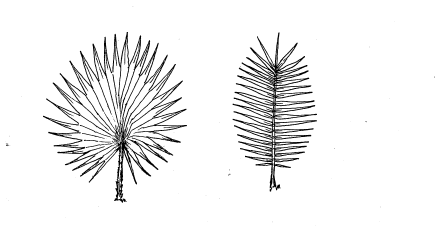
Figure 6.
Illustrations of leaf types: palmate (left) and pinnate (right).

Figure 7.
Illustrations of multiple-trunk (left) and single-trunk (right).

Figure 8.
Dr. Victor Maddox visits an oil palm (Elaeis guineensis) plantation in Puerto Rico.

Figure 9.
Coconut palm (Cocos nucifera) with fruit.

Figure 10.
Date palms (Phoenix canariensis) in Puerto Rico.

Figure 11.
Sago palms (Cycas revoluta) in Hawaii.

Figure 12.
Traveler palm (Ravenala madagascarensis) is not a true palm.

Figure 13.
Closeup of Dioon spinulosum, a rare cycad species from Mexico, showing sharp, stiff leaf margins.

Figure 14.
Cycads in a Puerto Rican landscape. Sago palms are in left background, and cardboard palm (Zamia furfuracea) is in right background.

Figure 15.
Two sago palms are used to accent the driveway entrance of this home.

Figure 16.
Feathery foliage of the Madagascar palm Crysalidocarpus lutescens).

Figure 17.
The large, blue-gray, fan-shaped foliage of the mature bismark palm (Bismarkia nobilis), when placed properly in the landscape, can make a large outdoor space appear smaller.
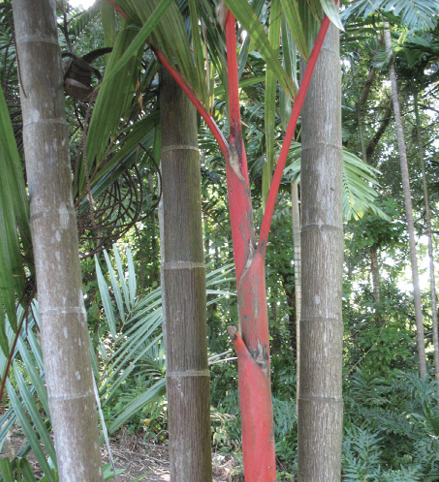
Figure 18.
The red shaft palm (Cyrtostachys renda) has brilliant red leaf petioles.
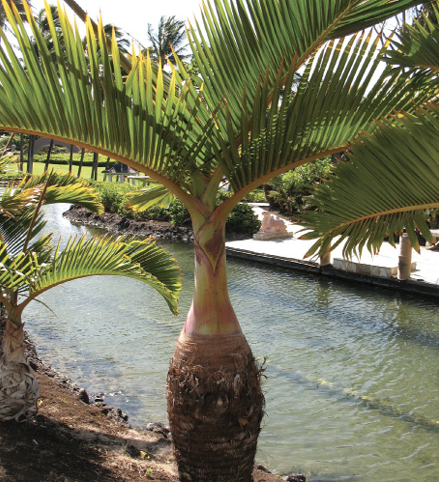
Figure 19.
The bottle palm (Hyophorbe lagenocaulis) produces an interesting-shaped trunk.
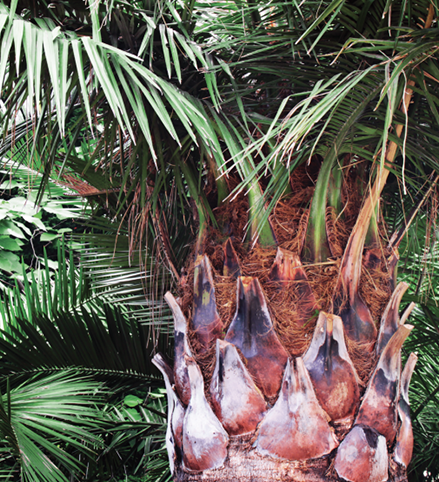
Figure 20.
As old palm leaves are removed, an interesting trunk is revealed.
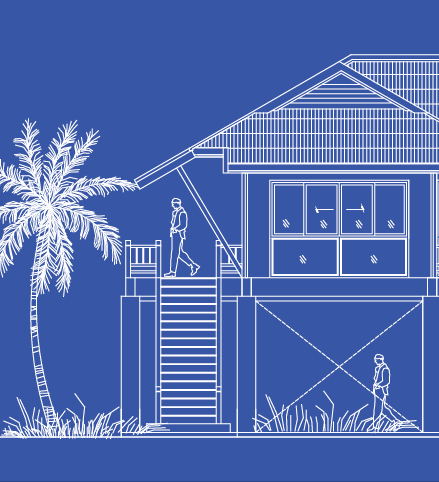
Figure 21.
Consider the mature height of plants when selecting varieties so that the plant will be in scale with its surroundings.
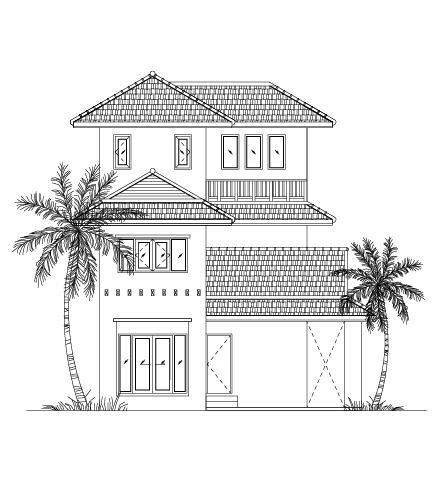
Figure 22.
Notice how the palm on the left is in scale with the higher roofline, and the smaller palm on the right is in scale with the lower roofline.
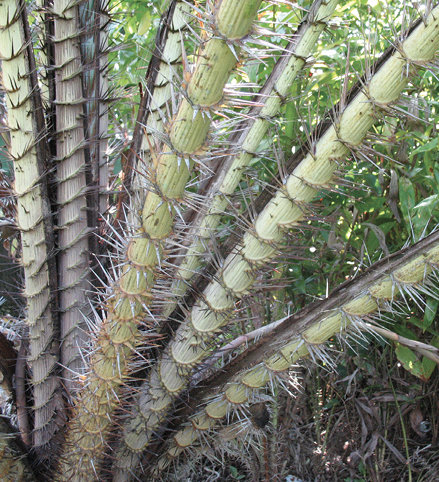
Figure 23.
Salacca (Salacca wallichiana) produces spines on the petioles.
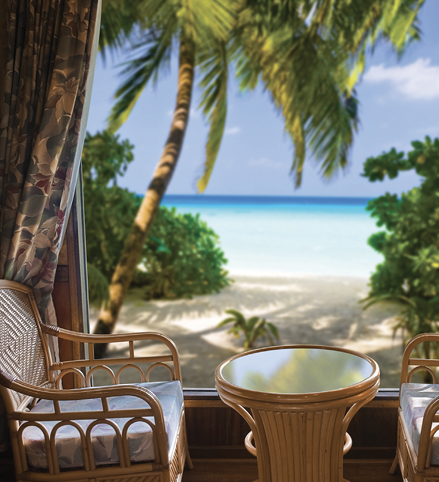
Figure 24.
The use of palms and cycads is not limited to tropical locales. There are cold-hardy selections that can add that tropical island look to Midsouth landscapes.

Figure 25.
This sago palm’s coarse, dark- green foliage contrasts well with the mottled, light-colored bark of crape myrtles.
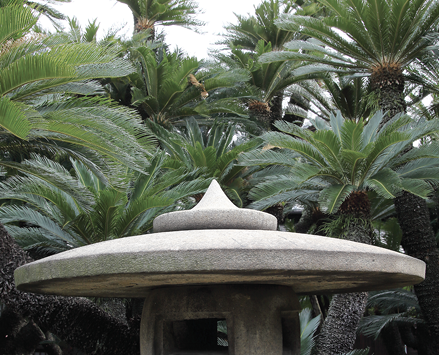
Figure 26.
Sago palms in various stages of growth make a nice background planting to frame this pagoda in a Japanese-style garden.
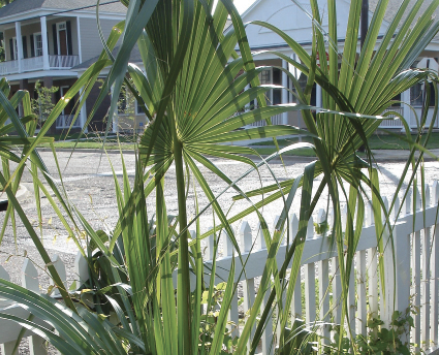
Figure 27.
The native Sabal palmetto adds a sense of place and another architectural dimension to this front yard planting bordered by a white picket fence.

Figure 28.
This professional plan incorporates large palms as background and screening plants in perimeter beds bordering these backyards.
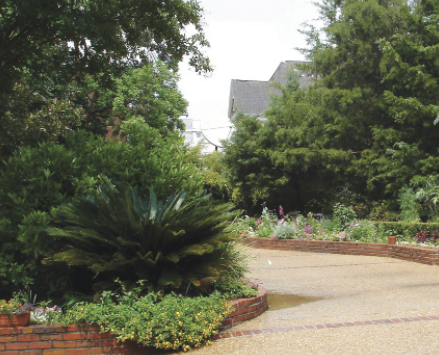
Figure 29.
This sago palm is used to accent the curve in the driveway entrance.
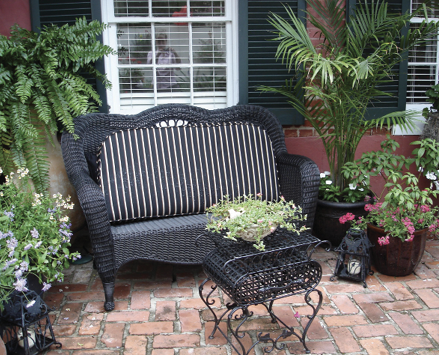
Figure 30.
The leafy canopy of the bamboo palm can provide shade for this sitting area. This moderate- sized species is well suited to containers.
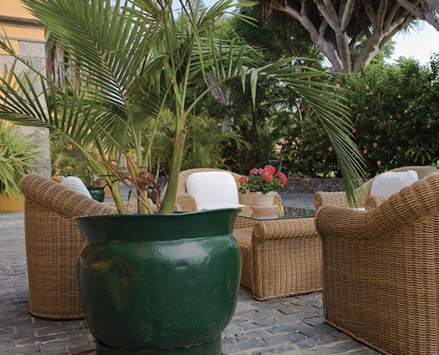
Figure 31.
Palms and cycads make attractive container plants. A large palm is used to draw attention and provide light shade to this sitting area.
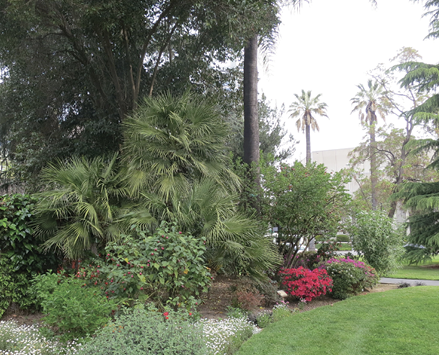
Figure 32.
Palms or cycads can be used effectively when combined with shrubs, perennials, and annuals in a mixed border.
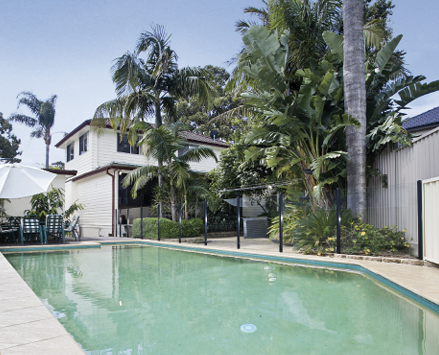
Figure 33.
Proper placement of various-sized palms provides shade for this house and pool area.

Figure 34.
Palms used around a garden pool act as a screen and contribute to the tropical atmosphere.
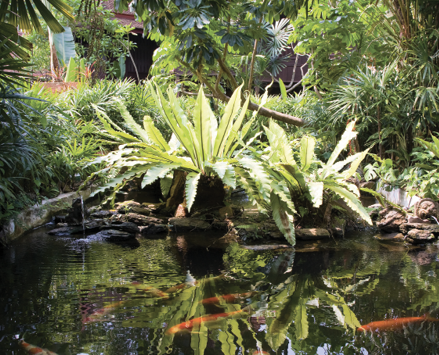
Figure 35.
The foliage reflections of palms and ferns in this garden koi pool add to the enjoyment and beauty of the landscape.

Figure 36.
A planting of large, mature bismark palms (Bismarkia nobilis) at a hotel in Puerto Rico.

Figure 37.
A grouping of various heights of sago palms is more effective and easier to achieve than a line or group of identical-height plants.

Figure 38.
Clumping European fan palms (Chamerops humilis) can be planted in a line without having to worry about the uniformity of the canopies.
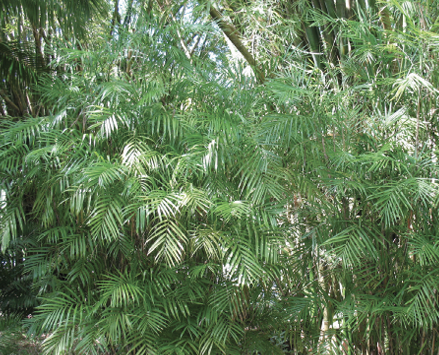
Figure 39.
Bamboo palm (Chamaedorea costariana) forms clumps.

Figure 40.
These large Mexican fan palms (Washingtonia robusta) are quite impressive lining a street in downtown Sacramento, but this type of formal, uniform planting is very difficult to achieve in the home landscape.
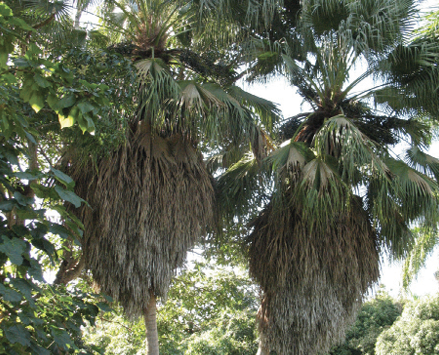
Figure 41.
California fan palm (Washingtonia filifera) retains its old leaves, which adds to the landscape interest.
Table 1. Selected palm species that are hardy from USDA Zones 6 to 9 based upon research and web resources.
|
Common Name |
Scientific Name |
Zone1 |
Light2 |
Spacing3 |
Height4 |
Width5 |
Type |
Origin |
Comments |
|
Red Palm |
Acanthophoenix crinita (Bory) H.Wendl. |
9b |
F–P |
4’–8’ |
15’ |
6’ |
Pinnate |
Reunion |
Also called white barbel palm. Has spines. Reportedly hardy to about 27°F. |
|
Paurotis Palm |
Acoelorrhaphe wrightii (Griseb. & H.A.Wendl.) Becc. |
9 |
F–P |
6’–10’ |
25’ |
6’ |
Palmate |
C. America– S. U.S. |
Reportedly hardy to 16 or 18–20°F, depending upon source. Profusely suckering and tolerates wet conditions. |
|
Gru Gru Palm |
Acrocomia aculeata (Jacq.) Lodd. ex Mart. |
9b |
F–P |
15’–20’ |
>40’ |
15’ |
Pinnate |
Mexico– S. America |
Some consider it synonymous with Acrocomia totai. Reportedly hardy to 28°F. Has spines on trunk. |
|
Gru Gru Palm |
Acrocomia totai Mart. |
9b |
F–P |
15’–20’ |
40’ |
15’ |
Pinnate |
S. America |
Reportedly hardy to 12°F. Synonymous with Acrocomia aculeata. Has spines on trunk. |
|
Seashore Palm |
Allagoptera arenaria Kuntze |
9b |
F–P |
3’–6’ |
6’ |
6’ |
Pinnate |
Brazil |
Also called sea or dwarf palm. A spiny, small, suckering (multi-trunk) palm. Reportedly hardy to 25°F. |
|
King Palm |
Archontophoenix cunninghamiana H.Wendl. & Drude |
9b |
F–P |
12’–15’ |
>60’ |
20’ |
Pinnate |
Australia |
Reportedly hardy to 24–26°F. |
|
Walsh River Palm |
Archontophoenix maxima Dowe |
9b |
F–P |
12’–15’ |
75’ |
20’ |
Pinnate |
Australia |
Similar to king palm, but larger. Reportedly hardy to about 26°F. |
|
Myola Palm |
Archontophoenix myolensis Dowe |
9b |
F–P |
12’–15’ |
>40’ |
20’ |
Pinnate |
Australia |
Similar to Walsh River palm and possibly has similar cold hardiness. |
|
Purple King Palm |
Archontophoenix purpurea Hodel & Dowe |
9b |
F–P |
4’–8’ |
40’ |
15’ |
Pinnate |
Australia |
Similar to king palm, and also called Mt. Lewis king palm, except purple crown shaft. Reportedly hardy to about 28°F. |
|
Taiwan Arenga Palm |
Arenga engleri Becc. |
9a |
F–S |
6’–15’ |
15’ |
15’ |
Pinnate |
Asia |
Also called dwarf sugar or Formosa palm. Reportedly hardy to 15–18°F, particularly if plants are mature. A suckering palm with fragrant blossoms. |
|
Sugar Palm |
Arenga pinnata (Wurmb) Merr. |
9b |
F–S |
6’–15’ |
>40’ |
30’ |
Pinnate |
Asia |
Also called arenga palm or solitary sugar palm. Reportedly hardy to the mid- to upper 20s. |
|
Bismarck Palm |
Bismarckia nobilis Hildebrandt & H.Wendl. |
9a |
F |
12’–15’ |
>40’ |
10’ |
Palmate |
Madagascar |
Also called Bismark palm. Very nice palm with silvery foliage. Nice accent species. Reportedly hardy to about 22°F, but not juvenile plants. |
|
Sinoloan Hesper Palm |
Brahea aculeata (T.S.Brandegee) H.E.Moore |
9a |
F–P |
7’–10’ |
30’ |
10’ |
Palmate |
Mexico |
Hardy to 10 or 18–20°F, depending upon source. Very tolerant of heat and wind. A rugged palm. Growth rate is slow. |
|
Mexican Blue Palm |
Brahea armata S.Watson |
9a |
F–P |
7’–10’ |
30’ |
10’ |
Palmate |
NW Mexico |
Also called blue hesper palm. Some report hardy to 10°F, but others report winter kill with temperatures of 15°F. Recommended for Zone 9 and south unless in a well protected area. Very tolerant of heat and wind. A rugged palm. Highly alkaline water may cause tip burn. Manganese deficiency can occur in alkaline soils. Maintain pH within recommended limits. Growth rate is slow. |
|
Guadalupe Palm |
Brahea edulis H.Wendl. |
9a |
F–P |
7’–10’ |
>30’ |
10’ |
Palmate |
Mexico |
Endangered on native Guadalupe Islands due to introduced goats. Some report hardy to 10°F, but others report winter kill with temperatures of 12–15°F. Recommended for Zone 9 and south unless in a well protected area. Very tolerant of heat and wind. A rugged palm. Maintain pH within recommended limits. Growth rate is slow. |
|
Dwarf Rock Palm |
Brahea moorei L.H.Bailey ex H.E.Moore |
8a |
F–S |
4’–6’ |
4’ |
4’ |
Palmate |
Mexico |
Smaller, more shade tolerant Brahea. Some report hardy 26–28°F. |
|
White Rock Palm |
Brahea nitida Liebm. |
9a |
F–P |
7’–10’ |
>30’ |
10’ |
Palmate |
Mexico– C. America |
Synonymous with Brahea calcarea. Some report hardy to about 10°F, but others report winter kill with temperatures of 12–15°F. Recommended for Zone 9 and south unless in a well protected area. Very tolerant of heat and wind. A rugged palm. Maintain pH within recommended limits. Growth rate is slow. |
|
Hapala Palm |
Burretiokentia hapala H.E.Moore |
9b |
P–S |
6’–10’ |
20’ |
10’ |
Pinnate |
New Caledonia |
Reportedly hardy into the mid-20s. |
|
Pindo Palm |
Butia capitata (Mart.) Becc. |
8a |
F–P |
7’–10’ |
15’ |
8’ |
Pinnate |
S. America |
Also called jelly palm. Reportedly hardy to 8°F, but have seen severe damage to young palms at 10°F. Best protected at low temperatures. Blue-gray appearance. Fruit used in jelly. |
|
Wooly Butia |
Butia eriospatha (Mart. ex Drude) Becc. |
8b |
F–P |
7’–10’ |
>15’ |
8’ |
Pinnate |
Brazil |
Also called woolly jelly palm. Similar to Butia captiata, but less cold tolerant. Reportedly hardy to 18–20°F. |
|
Jelly Palm |
Butia odorata (Barb. Rodr.) Noblick |
8 |
F–P |
5’–10’ |
6’ |
8’ |
Pinnate |
Brazil |
Smaller than Butia capitata and sometimes listed as a botanical variety. Reportedly hardy to around 15°F. |
|
Dwarf Yatay Palm |
Butia paraguayensis (Barb. Rodr.) L.H.Bailey |
9a |
F–P |
5’–10’ |
>10’ |
6’ |
Pinnate |
S. America |
Smaller than Butia capitata and may develop subterranean trunk. Reportedly hardy to 20°F. |
|
Mule Palm |
xButyagrus nabonnandii (Prosch.) Vorster |
8 |
F–P |
8’–10’ |
18’ |
8’ |
Pinnate |
S. America |
Hybrid between Butia capitata and Syagrus romanzoffiana. |
|
Fishtail Lawyer Cane |
Calamus caryoptoides Mart. |
9b |
P–S |
8’–10’ |
>40’ |
15’ |
Pinnate |
Australia |
Suckering palm with spines. Reportedly hardy to about 22°F. |
|
Fishtail Palm |
Caryota mitis Lour. |
9b |
P–S |
8’–10’ |
>20’ |
12’ |
Pinnate |
SE Asia–India |
Also called Burmese or clustered fishtail palm. Reportedly hardy to 28°F, but may be a better indoor species in the Midsouth. |
|
Giant Fishtail Palm |
Caryota obtusa Griff. |
9b |
F–P |
20’–30’ |
>40’ |
20’ |
Pinnate |
SE Asia–India |
Synonymous with Caryota gigas. Similar to fishtail palm but larger. Also called black trunk fishtail. Reportedly hardy to the low 20s. |
|
Jaggery Palm |
Caryota urens L. |
9b |
F–S |
8’–10’ |
>40’ |
20’ |
Pinnate |
SE Asia–India |
Also called toddy palm. Related to fishtail palm and also called fishtail wine palm. Needs lots of room. A monocarpic species (flowers and dies at around 25 years). Reportedly hardy to about 20°F. |
|
Andean Wax Palm |
Ceroxylon alpinum Bonpl. ex DC. |
9b |
F–P |
15’–25’ |
>40’ |
15’ |
Pinnate |
S. America |
Foliage beneath is white and powdery. Prefers humid, cool conditions (not hot). Reportedly hardy to 28°F. |
|
Quindio Wax Palm |
Ceroxylon quindiuense (Karst.) H.Wendl. |
9b |
F–S |
20’–30’ |
>40’ |
20’ |
Pinnate |
S. America |
Similar to Andean wax palm, but taller. Prefers humid, cool conditions (not hot). Young plants may not tolerate full sun. Reportedly hardy 27–28°F. |
|
Costa Rican Bamboo Palm |
Chamaedorea costericana Oerst. |
9b |
F–S |
8’–12’ |
25’ |
5’ |
Pinnate |
C. America |
Common in commerce. May not reach 30’ in cultivation. A multi-trunk palm reportedly hardy to about 26°F. |
|
Sangapilla Palm |
Chamaedorea fragrans Mart. |
9b |
P–S |
2’–4’ |
4’ |
3’ |
Pinnate |
S. America |
Small, multi-trunk palm reportedly hardy to 26°F, though some say leaf hardy to 20°F. Not commonly sold commercially. |
|
Tepejilote |
Chamaedorea klotzschiana H.Wendl. |
9b |
P–S |
2’–4’ |
10’ |
6’ |
Pinnate |
Mexico |
Small, single-trunk palm reportedly hardy to about 27°F. |
|
Metallic Palm |
Chamaedorea metallica O.F.Cook ex H.E.Moore |
9a |
F–S |
1’–2’ |
8’ |
2’ |
Pinnate |
S. Mexico |
Also called miniature fishtail palm. Leaves have metallic sheen surface. Small, single- trunk, miniature palm reportedly hardy to 26°F. Not commonly sold commercially, but have acquired it retail on the web. |
|
Miniature Queen Palm |
Chamaedorea plumosa Hodel |
9b |
S–P |
2’–5’ |
15’ |
4’ |
Pinnate |
S. Mexico |
Showy plumose foliage. Small, single-trunk palm reportedly hardy to 28°F, although some say 23°F. |
|
Hardy Bamboo Palm |
Chamaedorea microspadix Burret |
9a |
F–S |
3’–6’ |
8’ |
4’ |
Pinnate |
Mexico |
Miniature, multi-trunk palm reportedly hardy to 24°F, although some say 23°F. |
|
Radicalis Palm |
Chamaedorea radicalis Mart. |
8a |
F–S |
5’–7’ |
10’ |
6’ |
Pinnate |
W. Mexico |
Synonymous with Chamaedorea pringlei. Small, clump-forming palm reportedly hardy to 9°F, though some say leaf hardy to 20°F. Not commonly sold commercially. |
|
Pacaya Palm |
Chamaedorea tepejilote Liebm. |
9b |
P–S |
3’–8’ |
20’ |
6’ |
Pinnate |
Mexico– C. America |
A single-trunk palm reportedly hardy to 28°F. |
|
Red Leaf Palm |
Chambeyronia macrocarpa (Brongniart) Viellard ex Becc. |
9a |
P–S |
6’–8’ |
6’ |
4’ |
Pinnate |
New Caledonia |
Also known as red feather palm or flame thrower palm. A single-trunk palm reportedly hardy to 28°F. Very nice palm, but hard to find in commerce and a slow grower. |
|
European Fan Palm |
Chamerops humilis L. |
7b |
F–P |
5’–7’ |
15’ |
7’ |
Palmate |
Europe |
Also called Mediterranean fan palm. Reportedly hardy to 5°F. A blue form commercially available. Slow-growing and often with multiple trunks. |
|
Blue European Fan Palm |
Chamerops humilis var. argentea Andre |
7b |
F–P |
5’–10’ |
5’ |
6’ |
Palmate |
NW Africa |
This is a blue form synonymous with var. cerifera. Slow-growing and often with multiple trunks. |
|
Silver Copernicia Palm |
Copernicia alba Morong. |
9b |
F–P |
8’–12’ |
75’ |
10’ |
Palmate |
S. America |
Also called wax palm. Reportedly hardy to 18°F. |
|
Cyphophoenix |
Cyphophoenix elegans (Brongn. & Gris) H.Wendl. |
9b |
F–P |
4’–8’ |
20’ |
8’ |
Pinnate |
New Caledonia |
Synonymous with Kentia elegans. An elegant palm with smooth, single trunk. Reportedly hardy to 28°F. |
|
Plumose Dypsis |
Dypsis ambositrae Beentje |
9b |
F–P |
4’–8’ |
20’ |
8’ |
Pinnate |
Madagascar |
Very showy palm. Great accent palm that can grow relatively fast under good conditions. Reportedly hardy to 26°F. |
|
Triangle Palm |
Dypsis baronii (Becc.) Beentje & J.Dransf. |
9b |
F–S |
8’–10’ |
12’ |
6’ |
Pinnate |
Madagascar |
Very showy palm. Great accent palm. Reportedly hardy to 28°F. |
|
Peacock Palm |
Dypsis decaryi (Jum.) Beentje & J.Dransf. |
9b |
F–P |
10’–20’ |
20’ |
15’ |
Pinnate |
Madagascar |
Also called triangle palm. Very showy palms with three-sided stems. Relatively large when mature. Great accent palm that can grow relatively fast under good conditions. Reportedly hardy 24–28°F. |
|
Manambe Palm |
Dypsis decipiens (Becc.) Beentje & J.Dransf. |
9b |
F–P |
15–20’ |
25’ |
15’ |
Pinnate |
Madagascar |
Similar to peacock palm but naturally suckering. Great accent palm. Reportedly hardy 20–24°F. |
|
Bamboo Palm |
Dypsis lutescens (H.Wendl.) Beentje & J.Dransf. |
9a |
F–P |
4’–6’ |
20’ |
15’ |
Pinnate |
Madagascar |
Very showy suckering palm. Synonymous with Chrysalidocarpus lutescens. Great accent palm. Reportedly hardy to about 25°F. |
|
Triangle Palm |
Dypsis utilis (Jum.) Beentje & J.Dransf. |
9b |
P–S |
6’–10’ |
15’ |
8’ |
Pinnate |
Madagascar |
Very showy palm. Another suckering species. Great accent palm and fast growing under good conditions. Reportedly hardy to about 28°F. |
|
Jucara Palm |
Enterpe edulis Mart. |
9b |
F–P |
6’–12’ |
35’ |
10’ |
Pinnate |
S. America |
Also known as heart-of-palm or assai palm. A slender, elegant palm reportedly hardy to 26°F. |
|
Maya Palm |
Gaussia maya (O.F.Cook) H.J.Quero & Read |
9b |
S–P |
8’–12’ |
15’ |
8’ |
Pinnate |
Mexico– C. America |
Grows on high-pH soils in wild. Has swollen base when young. Reportedly hardy to about 26°F. |
|
Kentia Palm |
Howea forsteriana Becc. |
9b |
S–P |
15’–25’ |
>40’ |
20’ |
Pinnate |
Lord Howe Island |
Also called paradise, sentry, and thatch palm. A popular indoor palm. Reportedly hardy to about 26°F. |
|
Kentia Palm |
Howea belmoreana (C.Moore & F.Muell.) Becc. |
9b |
S–P |
12’–15’ |
30’ |
15’ |
Pinnate |
Lord Howe Island |
Also called curly or belmore sentry palm. Similar to Howea fosteriana but has recurved, more numerous leaves. Reportedly hardy to about 25°F or a bit cooler. |
|
Doum Palm |
Hyphaene dichotoma (White) Furt. |
9b |
F–P |
10’–20’ |
20’ |
10’ |
Palmate |
India |
Near threatened in the wild. A multi-trunk species. Reportedly hardy to 22°F, although some sources say 28°F. |
|
Chilean Wine Palm |
Jubaea chilensis (Molina) Baillon |
8b |
F–S |
20’–30’ |
>40’ |
20’ |
Pinnate |
S. America |
Reportedly hardy to 15°F, though others report 18°F. Slow-growing palm with long, arching, feathery fronds. Not commonly grown but a good plant. Will need protection in severe cold spells. Manganese deficiency can occur in alkaline soils. Maintain pH within recommended limits. Growth rate is slow. |
|
Pondo Coconut |
Jubaeopsis caffra Becc. |
9b |
F–P |
20’–30’ |
>30’ |
30’ |
Pinnate |
Africa |
A rather rare palm in commerce and in the wild. Suckers and is wind tolerant. Reportedly cold tolerant to about 22°F. |
|
Atherton Palm |
Laccospadix australasica H.Wendl. & Drude |
9b |
F–S |
8’–12’ |
15’ |
15’ |
Pinnate |
Australia |
Also called Queensland kentia. A miniature, multi-trunking species similar to Howea. Reportedly hardy to 26°F. Produces colorful red fruit. |
|
Spiny Licuala Palm |
Licuala spinosa Roxb. |
9b |
F–S |
4’–8’ |
12’ |
4’ |
Palmate |
SE Asia |
Also called mangrove fan palm and synonymous with Licuala horrida. A personal favorite genus with a very tropical appearance, but generally slow-growing and not easy to find commercially. Multi-trunking, spiny, and reportedly cold tolerant to between 26 and 28°F. Most species of Licuala are not as cold tolerant. |
|
Walking-Stick Palm |
Linospadix monostachy (Mart.) H.Wendl. |
9b |
S |
1’–3’ |
8’ |
3’ |
Pinnate |
Australia |
A tiny, single-trunked rainforest palm that is easy to find commercially. It is reportedly cold tolerant to 26–28°F. |
|
Australian Fan Palm |
Livistona australis (R.Br.) Mart. |
9a |
F–P |
7’–10’ |
>40’ |
8’ |
Palmate |
Australia |
Also called Australian cabbago palm. Reportedly hardy to 10 or 20°F, depending upon source. Less common in commerce than Chinese fan palm. |
|
Chinese Fan Palm |
Livistona chinensis R.Br. |
8b |
F–S |
7’–10’ |
>25’ |
8’ |
Palmate |
China |
Reportedly hardy to 12 or 18–20°F, though temperatures below 25 can cause significant foliar damage, and 10°F can kill young palms. Commonly sold commercially, and foliage similar to fan palms (Washingtonia spp.). |
|
Weeping Cabbage Palm |
Livistona decipiens Becc. |
9a |
F–P |
10’–15’ |
>40’ |
12’ |
Palmate |
Australia |
Also called fountain or ribbon palm. Reportedly hardy to 12 or 18°F, depending upon source. Not common in commerce. |
|
Queensland Dwarf Fan Palm |
Livistona muelleri F.M.Bailey |
9b |
F–P |
8’–10’ |
25’ |
10’ |
Palmate |
Australia |
Reportedly hardy to 22°F. Not common in commerce. |
|
Taraw Palm |
Livistona saribus (Lour.) Merr. ex A.Chev. |
9b |
F–S |
12’–20’ |
>40’ |
12’ |
Palmate |
Thailand |
Reportedly hardy to 18 or 24°F, depending upon source. Not common in commerce. Petiole margins armed, so use caution when handling. |
|
Mazari Palm |
Nannorrhops richtiana (Griff.) Aitch. |
8 |
F–P |
4’–6’ |
4’ |
4’ |
Palmate |
Middle East |
Slow-growing desert palm. Reportedly hardy to -4°F, but have seen small plants killed at much higher temperatures. Relatively new to trade. |
|
Bronze Palm |
Oraniopsis appendiculata (F.M.Bailey) J.Dransf., A.K.Irvine & N.W. Uhl |
9b |
F–P |
10’–15’ |
35’ |
12’ |
Pinnate |
Australia |
Slow-growing, single-trunked palm reportedly hardy to 27°F. |
|
Mountain Coconut |
Parajubaea cocoides Burret |
9a |
F–P |
6’–12’ |
30’ |
10’ |
Pinnate |
S. America |
Also called coco cumbe or quito palm. Fruit very large. Reportedly hardy to 24°F. |
|
Bolivian Mountain Coconut |
Parajubaea torallyi (Mart.) Burret |
9a |
F–P |
10’–15’ |
>40’ |
15’ |
Pinnate |
Bolivia |
Fruit very large. Endangered in Bolivia. Reportedly hardy to 24°F. |
|
Canary Island Date Palm |
Phoenix canariensis Chabaud |
9a |
F–P |
25’–35’ |
>60’ |
30’ |
Pinnate |
Canary Island |
Similar to date palm. Will withstand heavy mulching. Reportedly hardy to 16°F, but 12–15°F will damage foliage. Needs much fertilizer. When started small, can be confined to a container. Difficult to tell from regular date palm. Manganese deficiency can occur in alkaline soils. Maintain pH within recommended limits. Growth rate is medium. |
|
Date Palm |
Phoenix dactylifera L. |
8b |
F–P |
25’–35’ |
>70’ |
30’ |
Pinnate |
Middle East |
Usually a very large palm. Needs lots of room. Reportedly hardy to 12°F, but leaves will burn at 20°F and plants may be killed at 10°F. Once it reaches larger sizes, this palm seems to be more hardy. Protect when small. May not flower and fruit on sandy, droughty soils. Manganese deficiency can occur in alkaline soils. Maintain pH within recommended limits. Growth rate is medium-slow. |
|
Pygmy Date Palm |
Phoenix humilis Royle ex Becc. |
9b |
F–P |
10’–15’ |
20’ |
10’ |
Pinnate |
Asia |
Synonymous with Phoenix loureirii var humilis or Loureiro’s date palm and also called mountain date palm. Hardy to 20°F, but some sources say hardy in Zone 8. Some recommend protecting palm if temperatures are expected to drop into the 20s. Foliage plume-like. |
|
Senegal Date Palm |
Phoenix reclinata Jacq. |
9a |
F–P |
15’–20’ |
45’ |
30’ |
Pinnate |
Africa |
A suckering palm (clumping) with spines. Reportedly hardy to 18°F. |
|
Pygmy Date Palm |
Phoenix roebelenii O’brien |
9a |
F–P |
12’–15’ |
10’ |
4’ |
Pinnate |
SE Asia |
Small palm, often grown in clusters. Commonly sold commercially. Reportedly hardy to 25°F. Has spines. |
|
Cliff Date Palm |
Phoenix rupicola T.Anders. |
9b |
F–P |
6’–12’ |
25’ |
10’ |
Pinnate |
India–Bhutan |
Similar to P. canariensis but smaller. Reportedly hardy to 25°F. Has spines like other date palms. |
|
Silver Date Palm |
Phoenix sylvestris (L.) Roxb. |
9a |
F–P |
20’–30’ |
>40’ |
30’ |
Pinnate |
Pakistan– India |
Also called sugar or India date palm. Showy gray-green foliage. Large palm similar to Canary Island date palm, but not as large. Reportedly hardy at 20–22°F. |
|
Buri Palm |
Polyandrococos caudescens Barb. Rodr. |
9b |
F–P |
10’–15’ |
30’ |
15’ |
Pinnate |
Brazil |
Silvery leaves. Reportedly hardy to at least 27°F. Produces showy, orange fruit. |
|
Solitaire Palm |
Ptychosperma elegans (R.Br.) Blume |
9b |
F–P |
3’–6’ |
35’ |
6’ |
Pinnate |
Australia |
Also known as Alexander palm. Sometimes sold as Adonidia palm. Has an elegant appearance. Reportedly hardy to 26–28°F, but might show damage. |
|
Sihara Palm |
Ravenea glauca Jum. & H.Perrier |
9b |
F–S |
6’–8’ |
15’ |
6’ |
Pinnate |
Madagascar |
Another rare palm from Madagascar. Reportedly hardy to 26–28°F. Rather small compared to other Ravenea spp. |
|
Ravenea Palm |
Ravenea Magascariensis Becc. |
9b |
F–P |
10’–15’ |
>40’ |
10’ |
Pinnate |
Madagascar |
Very attractive palm with silvery foliage. Reportedly hardy to about 26°F. |
|
Majestic Palm |
Ravenea rivularis Jum. & H.Perrier |
9b |
F–S |
6’–8’ |
>40’ |
8’ |
Pinnate |
Madagascar |
Commonly sold in commerce, but endangered in Madagascar. Reportedly hardy to about 27°F, but might show damage on young plants. Relatively fast grower. |
|
Needle Palm |
Rhapidophyllum hystrix (Pursh) H.Wendl. & Drude |
6 |
P–S |
3’–4’ |
6’ |
6’ |
Palmate |
U.S. |
Reportedly hardy to -20°F, making it possibly the most cold hardy palm. Dark-green leaves are silvery beneath. Makes an attractive accent plant. Black, needle-like spines arise along the trunk. Manganese deficiency can occur in alkaline soils. Maintain pH within recommended limits. Growth rate is |
|
Lady Palm |
Rhapis excelsa (Thunb.) Rehder |
9a |
P–S |
6’–10’ |
10’ |
3’ |
Palmate |
Asia |
Excellent for containers. Reportedly hardy to 18 or 20°F, depending upon source. Dense foliage makes this plant an excellent one for accent. Growth rate is medium. |
|
Slender Lady Palm |
Rhapis humilis Blume |
9b |
F–P |
3’–6’ |
20’ |
3’ |
Palmate |
Asia |
Similar to lady palm, but larger. Produces multiple trunks. Reportedly hardy to the mid-20s. |
|
Finger Palm |
Rhapis multifida Blume |
9b |
P–S |
8’–10’ |
10’ |
3’ |
Palmate |
China |
Similar to lady palm. Also called jade empress. Reportedly hardy to the mid-20s. |
|
Norfolk Island Palm |
Rhopalostylis baueri (Hook.f.) H.Wendl. & Drude |
9b |
F–P |
12’–18’ |
>40’ |
15’ |
Pinnate |
Australia–New Zealand |
Single-trunked, slow-growing palm. Reportedly hardy to 24–26°F. |
|
Shaving Brush Palm |
Rhopalostylis sapidai H.Wendl. & Drude |
9b |
F–S |
10’–12’ |
30’ |
12’ |
Pinnate |
New Zealand |
Also called Nikau palm. Similar to Norfolk Island palm. Reportedly hardy to 24–26°F. From southern New Zealand—the world’s southernmost palm. |
|
Royal Palm |
Roystonea regia (Kunth) O.F.Cook |
9b |
F |
15’–20’ |
~80’ |
15’ |
Pinnate |
Florida & Mexico– S. America |
Also called Cuban royal or Florida royal palm. Synonymous with Roystonia elata. Endangered in Florida. Large, smooth trunk, often found on low ground in Florida. Reportedly hardy to about 26–28°F, but may be better in Zones 10a south. |
|
Bermuda Palmetto |
Sabal bermudana L.H.Bailey |
9a |
F–P |
15’–30’ |
35’ |
15’ |
Palmate |
U.S. |
Reportedly hardy to 15°F. Similar to dwarf palmetto. |
|
Puerto Rico Hat Palm |
Sabal causiarum (O.F.Cook) Becc. |
8a |
F–P |
10’–15’ |
>40’ |
15’ |
Palmate |
Caribbean |
Reportedly hardy to 20°F. Similar to sabal palmetto, but possibly larger. |
|
Scrub Palmetto |
Sabal etonia Swingle ex Nash |
7b |
P–S |
3’–6’ |
8’ |
4’ |
Palmate |
U.S. |
Reportedly hardy to 5°F. Similar to dwarf palmetto. |
|
Mexican Palmetto |
Sabal mexicana Mart. |
8a |
F–P |
12’–18’ |
>40’ |
15’ |
Palmate |
U.S.–Mexico |
Also called Texas palmetto. Reportedly hardy to 16°F. Grows wild in Texas and northern Mexico. Very similar to cabbage palmetto. |
|
Dwarf Palmetto |
Sabal minor (Jacq.) Pers. |
6 |
F–S |
7’–10’ |
7’ |
10’ |
Palmate |
U.S. |
|
|
Louisiana Dwarf Palmetto |
Sabal minor var. louisiana |
7 |
F–S |
8’–12’ |
12’ |
10’ |
Palmate |
U.S. |
Native to Louisiana and east Texas. Like dwarf palmetto, does well on wet soils. May or may not be a variety of Sabal minor. |
|
Cabbage or Palmetto Palm |
Sabal palmetto (Walt.) Lodd. ex Schult. & Schult.f. |
8a |
F–P |
12’–15’ |
35’ |
15’ |
Palmate |
U.S.– Caribbean |
|
|
Sonoran Palmetto |
Sabal uresana Trel. |
7 |
F–P |
8’–10’ |
40’ |
8’ |
Palmate |
NW Mexico |
Often has grayish foliage. Reportedly very hardy in Georgia, but some sources say hardy only to 9a. |
|
Saw Palmetto |
Serenoa repens (W.Bartram) Sm. |
7 |
F–P |
4’–6’ |
8’ |
20’ |
Palmate |
U.S. |
Reportedly hardy to -5°F, but others report only 5–10°F. Typical form grows laterally on the ground, so can require some space over time. Occurs naturally in southern MS on sandy soils. Difficult to transplant from the wild. A blue form sold commercially. Growth rate can be slow. |
|
Licuri Palm |
Syagrus coronata (Cham.) Glassman |
9b |
F–P |
12’–20’ |
30’ |
15’ |
Pinnate |
Brazil |
Also called ouricury palm. Reportedly hardy to about 26°F, but have seen severe foliar damage at higher temperatures. Fast growing and can be invasive in Florida. |
|
Queen Palm |
Syagrus romanzoffiana (Cham.) Glassman |
8b |
F–P |
20’–30’ |
>40’ |
20’ |
Pinnate |
S. America |
A showy palm. Also called cocos palm. Reportedly hardy to 17°F, but have seen severe foliar damage at higher temperatures. Fast growing and can be invasive in Florida. |
|
Windmill Palm |
Trachycarpus fortunei (Hook.) H.Wendl. |
7 |
F–S |
7’–10’ |
40’ |
6’ |
Palmate |
Asia |
Easily transplanted. Reportedly hardy to 0–5°F. Trunk covered with fibers, giving the appearance of being covered with dark burlap. Will not grow well in poorly drained areas. Tolerant of salt spray. Highly resistant to wind. Manganese deficiency can occur in alkaline soils. Maintain pH within recommended limits. Can escape cultivation from seed when mature. |
|
Khasia Palm |
Trachycarpus martianus (Wall.) H.Wendl. |
9a |
F–P |
8’–12’ |
30’ |
6’ |
Palmate |
Asia |
Easily transplanted. Reportedly hardy to 5°F, but others sources report only hardy to 20°F. Similar to windmill palm. |
|
Yunnan Dwarf Palm |
Trachycarpus nanus Becc. |
7 |
F–P |
3’–5’ |
3’ |
3’ |
Palmate |
China |
Very slow-growing palm. Reportedly hardy to 10°F, possibly lower based upon personal observation. Has a subterranean trunk. |
|
Kumaon Palm |
Trachycarpus takil Becc. |
7 |
F–S |
7’–10’ |
40’ |
6’ |
Palmate |
Asia |
Reportedly hardy to -5°F, although some say 15°F. Similar to windmill palm. |
|
Miniature Chusan Palm |
Trachycarpus wagnerianus Hort. ex Becc. |
8a |
F–P |
7’–10’ |
20’ |
6’ |
Palmate |
Asia |
Reportedly hardy to -3°F, although some say 15 or 20°F. Similar to windmill palm and now considered the same species. |
|
Spiny Fibre Palm |
Trithrinax acanthicoma Drude |
8b |
F–P |
7’–10’ |
>15’ |
6’ |
Palmate |
S. America |
Also called Brazilian needle palm, and some consider this species synonymous with T. brasiliensis. Reportedly hardy to 9, 12, or 15°F. Has spines on trunk. |
|
Brazilian Needle Palm |
Trithrinax brasiliensis Mart. |
8b |
F–P |
7’–10’ |
>15’ |
6’ |
Palmate |
S. America |
Reportedly hardy to 9°F. Very similar to Trithrinax acanthocoma. |
|
Campestre Palm |
Trithrinax campestris (Burmeist.) Drude & Griseb. |
8b |
F–P |
6’–10’ |
>15’ |
6’ |
Palmate |
S. America |
Also called caranday, thatch, and blue needle palm. A suckering (multi-trunk) palm. Reportedly hardy to 7°F, but some sources say only hardy to 18–20°F. |
|
California Fan Palm |
Washingtonia filifera (Andre) H.Wendl. |
8a |
F–P |
12’–18’ |
>40’ |
10’ |
Palmate |
U.S.–Mexico |
Tall, straight, slender trunks with globular head of foliage. Reportedly hardy to 8°F, but some sources say only hardy to 10 or 16°F when older, and foliage can burn at 25°F when young. Manganese deficiency can occur in alkaline soils. Maintain pH within recommended limits. Growth rate is medium-slow. |
|
Mexican Fan Palm |
Washingtonia robusta H.Wendl. |
9a |
F–P |
15’–40’ |
>40’ |
12’ |
Palmate |
U.S.–Mexico |
Tall, thick trunks. More tolerant of SE U.S. climate than W. filifera. Will withstand temperatures to 16°F when older, but 18–20°F may be correct since 12–15°F can defoliate. Foliage injury common due to cold. Growth rate is medium. |
|
Foxtail Palm |
Wodyetia bifurcata Irvine |
9b |
F–P |
6’–12’ |
25’ |
8’ |
Pinnate |
Australia |
Very attractive, single-trunk palm. Genus named after the Aboriginal man who brought it to botanists in 1978. Reportedly hardy to about 24°F. |
1Zone refers to USDA Cold Hardiness Zones and is based upon web resources and research for each species. Refer to the comments section for additional information. Young palms are usually more sensitive to cold. Also, palms usually exhibit within-species genetic variability for cold tolerance. Short cold periods are generally less damaging than long periods of cold. Site location can affect cold tolerance.
2Light: F=full sun; P=part sun; S=shade.
3Spacing is provided here as a landscape planting guide. Young palms require less space, but they will need more space when mature. Spacing is based upon mature size.
4Height is provided here as a guide to planting and based upon mature height. Some species may take many years to obtain mature height.
5Width is provided here as a guide to planting and based upon mature plant width. Plants may take several years to obtain mature width.
Table 2. Selected cycad species that are hardy from USDA Zones 7 to 9 based upon research and web resources.
|
Common Name |
Scientific Name |
Zone1 |
Light2 |
Spacing3 |
Height4 |
Width5 |
Origin |
Comments |
|
Byfield Fern |
Bowenia serrulata (W.Bull) Chamb. |
9b |
P–S |
2’–6’ |
6’ |
6’ |
Australia |
Not a fern, but a very unusual cycad in the Stangeriaceae family. Has compound leaves. Reportedly hardy to about 23°F. |
|
Bamboo Cycad |
Ceratozamia hildae G.P.Landry & M.C.Wilson |
9a |
F–S |
6’–10’ |
8’ |
6’ |
Mexico |
Endangered in Mexico. Reportedly hardy to 20°F, although some sources say hardy to zone 8a. Foliage has appearance of a bamboo. |
|
Ceratozamia |
Ceratozamia robusta Miq. |
9a |
P–S |
10’–15’ |
10’ |
6’ |
Mexico– C. America |
Endangered. An attractive cycad resembling a fern. |
|
Blue Cycad |
Cycas couttsiana K.D.Hill |
9b |
S–P |
3’–6’ |
3’ |
3’ |
Australia |
Beautiful cycad with grayish foliage. Some say only hardy to zone 10a. Near threatened in Australia. |
|
Multipinnate Cycad |
Cycas debaoensis Y.C.Zhong & C.J.Chen |
9b |
S–P |
10’–20’ |
10’ |
8’ |
China |
Critically endangered in China. Large, very showy cycad with rather finely cut foliage. Reportedly hardy to 17°F, but some sources say only hardy to zone 10a. |
|
Guizhou Sago Palm |
Cycas guizhouensis K.M.Lan & R.F.Zou |
8b |
S–P |
6’–8’ |
6’ |
6’ |
China |
Similar to Cycas revoluta but showier (in author’s opinion). Endangered in China. Reportedly hardy to about 17°F. |
|
Panzihua Sago Palm |
Cycas panzhihuaensis L.Zhou & S.Y. Yang |
8b |
F–P |
6’–12’ |
6’ |
6’ |
China |
Similar to Cycas revoluta in appearance. Another rare species from China. Reportedly hardy to about 16–19°F, although some sources say only hardy to zone 9a. |
|
Pectinate Sago Palm |
Cycas pectinata Buck.–Ham. |
9b |
F–P |
12’–15’ |
25’ |
10’ |
India– SE Asia |
Rather large cycad. Rare where native. Reportedly hardy to 26°F. |
|
Loei Sago |
Cycas petraea A.Lindstr. & K.D.Hill |
9b |
F–P |
6’–10’ |
20’ |
6’ |
Thailand |
Rather tall cycad that grows on rock in Thailand. Listed as near threatened. Reportedly hardy to about 25°F, although some sources say only hardy to zone 10a. |
|
Cycad |
Cycas platyphylla K.D.Hill |
9b |
F–P |
4’–8’ |
6’ |
6’ |
Australia |
Often has showy gray foliage. Endangered in Australia. |
|
Sago Palm |
Cycas revoluta Thunb. |
8b |
F–P |
8’–10’ |
15’ |
6’ |
Japan |
Common species planted along the Gulf Coast. Also called king sago, sago cycad, and Japanese sago palm. Reportedly hardy to 19°F. |
|
Emperor Sago Palm |
Cycas taitungensis Shen, Hill, Tsou & Chen |
9a |
F–S |
4’–6’ |
20’ |
6’ |
Taiwan |
Also known as prince sago. Endangered in Taiwan. Reportedly hardy to about 21°F (9a), but some sources say as low as Zone 8a or 7b (7°F) with protection. Foliage will likely be damaged in 7b. |
|
Narrowleaf Dioon |
Dioon angustifolium Miq. |
8b |
F |
2’–4’ |
8’ |
4’ |
Mexico |
Another rare cycad from Mexico. Synonymous with Dioon edule var. angustifolium. Reportedly hardy to about 17°F and sources are mixed on Zone 8b or 9a for hardiness. |
|
Dioon |
Dioon califanoi De Luca & Sabato |
9a |
F |
7’–10’ |
8’ |
6’ |
Mexico |
An endangered species in Mexico. Leaves covered with hairs. Reportedly hardy to 23°F. |
|
Royal Palm |
Dioon caputoi De Luca, Sabato & Vazq. Torres |
9a |
F |
2’–4’ |
3’ |
3’ |
Mexico |
Rather small and very rare in Mexico. Critically endangered with only about 310 plants remaining in the wild. Only recently (1980) described as a new species. Some sources recommended for Zone 9b south. Adapted to very poor, rocky conditions. |
|
Chestnut Dioon |
Dioon edule Lindl. |
8b |
F–P |
6’–12’ |
6’ |
6’ |
E. Mexico |
Increasingly rare in Mexico where it is native. Synonymous with Dioon edule var. edule, among others. Also called edible-seed cycads. There is apparently cold hardiness variability based upon plant origin in Mexico, and some of these forms are marketed as such. Reportedly hardy to around 20°F, but others report colder. |
|
Dioon |
Dioon merolae De Luca, Sabato & Vazq. Torres |
9a |
F |
4’–8’ |
12’ |
6’ |
Mexico |
Very showy, rather grayish species. Rare and only recently (1981) described as a new species. Some report hardy to 23°F, but some say only hardy to zone 9b south. |
|
Dioon |
Dioon purpusii Rose |
9a |
F–P |
4’–6’ |
12’ |
6’ |
Mexico |
Another rare Dioon from Mexico. Foliage somewhat grayish in color. Reportedly hardy to 23°F. |
|
Eastern Cape Giant Cycad |
Encephalartos altensteinii Lehm. |
9b |
F–P |
6’–10’ |
15’ |
8’ |
South Africa |
Also known as bread tree and Altenstein’s cycad. A rare cycad that is quite large and very showy. Reportedly hardy to around 26°F. |
|
Ngotshe Cycad |
Encephalartos aemulans Vorster |
9b |
F |
6’–8’ |
12’ |
8’ |
South Africa |
A critically endangered species. Hardy to 9a according to some sources. |
|
Alexandria Cycad |
Encephalartos arenarius R.A.Dyer |
9b |
F–P |
7’–10’ |
6’ |
6’ |
South Africa |
Also called dune cycad. An endangered and very showy blue cycad with spiny leaves. Some sources say this species is sensitive to frost. |
|
Eastern Cape Dwarf Cycad |
Encephalartos caffer (Thunb.) Lehm. |
9b |
F–P |
3’–6’ |
4’ |
3’ |
South Africa |
Another rare but showy African encephalartos. Also called Caffrarian cycad and one of the first cycads to be protected in South Africa. Also the most southern cycad in Africa. |
|
Waterberg Cycad |
Encephalartos eugene–maraisii I.Verd. |
9a |
F |
4’–8’ |
8’ |
6’ |
South Africa |
Also called Bergpalm. Like many other cycads, this species is endangered. Often exhibits blue foliage color. Very showy. Some sources say hardy to 8b. |
|
White-haired Cycad |
Encephalartos friderici–guilielmi Lehm. |
9a |
F |
4’–6’ |
6’ |
6’ |
South Africa |
Similar to the previous species, very showy and rare. Some sources say hardy to zone 8b. |
|
Eastern Cape Blue Cycad |
Encephalartos horridus (Jacq.) Lehm. |
9a |
F |
4’–6’ |
4’ |
4’ |
South Africa |
One of the author’s personal favorites, although not a large cycad. Blue, spiny (also known as ferocious blue cycad) foliage and very showy, but endangered in Africa. Reportedly hardy to about 25°F. |
|
Woolly Cycad |
Encephalartos lanatus Stapf & Burtt Davy |
9b |
F |
3’–6’ |
6’ |
5’ |
South Africa |
Also called Olifants River cycad and rare in Africa. Reportedly hardy to 9°F (8b), but other sources say 9b. |
|
Lebombo Cycad |
Encephalartos lebomboensis I.Verd. |
9b |
F–P |
3’–6’ |
10’ |
6’ |
South Africa |
A rare and showy species of cycad. Reportedly hardy to around 25°F (9a), although other sources say only hardy to zone 9b. |
|
Karoo Cycad |
Encephalartos lehmannii Lehm. |
9b |
F |
4’–8’ |
6’ |
4’ |
South Africa |
Another showy, rare, blue-foliage species. Not very large. Reportedly hardy to about 22°F (9a), but some sources say only hardy to zone 9b. |
|
Breadpalm |
Encephalartos longifolius Lehm. |
9b |
F–P |
6’–10’ |
8’ |
6’ |
South Africa |
Also known as broodboom or Suurberg cycad, and near threatened in Africa. Some sources list this species as hardy in zone 9a. |
|
Middleburg Cycad |
Encephalartos middelburgensis Vorster |
9b |
F |
6’–10’ |
15’ |
6’ |
South Africa |
Very showy, gray-leaf species. Critically endangered in Africa. Depending upon the source, this species is listed as hardy in zones 8b or 10a south. Zone 9b south may be safer. |
|
Natal Cycad |
Encephalartos natalensis R.A.Dyer & I.Verd. |
9a |
F–P |
6’–10’ |
20’ |
6’ |
South Africa |
Also called Natal giant cycad. A rare and very large species. Some sources list hardiness to about 25°F, but others say to about 21°F. |
|
Kei River Cycad |
Encephalartos princeps R.A.Dyer |
9b |
F |
6’–10’ |
12’ |
6’ |
South Africa |
Showy and rare species also called Kei cycad. Some sources say hardy to about 25°F or zone 9a. |
|
Jozini Cycad |
Encephalartos senticosus Vorster |
9b |
F–P |
6’–10’ |
8’ |
6’ |
South Africa |
Very rare and similar to E. lebomboensis. Some say hardy to zone 9a, but other sources say only hardy to about 30°F. |
|
Modjadji Cycad |
Encephalartos transvenosus Stapf & Burtt Davy |
9b |
F–P |
8’–12’ |
12’ |
8’ |
South Africa |
A rather large species. Very showy. |
|
Bushman’s River Cycad |
Encephalartos trispinosus (Hook.) R.A.Dyer |
9b |
F |
3’–6’ |
4’ |
4’ |
South Africa |
Rare in Africa and similar to E. horrida. Very showy. Some sources say hardy to zone 9a. |
|
Poor Man’s Cycad |
Encephalartos villosus Lem. |
9b |
P–S |
6’–10’ |
6’ |
6’ |
South Africa |
A relatively small cycad. Some sources say hardy to zone 9a. |
|
Scaly Zamia |
Lepidozamia peroffskyana Regel |
9b |
F–S |
10’–20’ |
15’ |
10’ |
Australia |
Rather large cycad. Very showy and has a wide range of light tolerance. Some sources say hardy to zone 9a. |
|
Burrawang |
Macrozamia communis L.A.S. Johnson |
9a |
P–S |
6’–10’ |
8’ |
6’ |
Australia |
Some sources say hardy to 8b, but others say only to around 25°F (9a). |
|
Johnson’s Cycad |
Macrozamia johnsonii D.L.Jones & K.D.Hill |
9a |
F–P |
10’–15’ |
10’ |
8’ |
Australia |
Also known as New South Wales cycad. Relatively large species. Very showy. Reportedly hardy to about 20°F. |
|
Carnarvon Gorge Macrozamia |
Macrozamia moorei F.Muell. |
9a |
F |
10’–15’ |
12’ |
10’ |
Australia |
Relatively large species. Very showy. Reportedly hardy to about 20–21°F. |
|
Mt. Perry Cycad |
Macrozamia mountperriensis F.M.Bailey |
9b |
P–S |
2’–3’ |
3’ |
3’ |
Australia |
A small cycad. Delicate and fern-like in appearance. Some sources say hardy to around 22°F (9a). |
|
Cardboard Palm |
Zamia furfuracea L.f. en Ait. |
9b |
F–P |
6’–8’ |
4’ |
4’ |
Mexico |
Also called cardboard cycad. Rare in Mexico, but rather common in cultivation. Some sources say hardy to zone 8a. |
|
Coontie |
Zamia pumila L. |
8b |
F–S |
3’–4’ |
3’ |
3’ |
SE U.S.– Caribbean |
Rather common in cultivation. Synonymous with Zamia floridana and also known as dwarf zamia, comfort root, and arrowroot. Some sources say hardy to zone 8a. |
1Zone refers to USDA Cold Hardiness Zones and is based upon web resources and research for each species. Refer to the comments section for additional information. Young palms are usually more sensitive to cold. Also, palms usually exhibit within-species genetic variability for cold tolerance. Short cold periods are generally less damaging compared to long periods of cold. Site location can affect cold tolerance.
2Light: F=full sun; P=part sun; S=shade.
3Spacing is provided here as a landscape planting guide. Young cycads require less space, but they will need more space when mature. Spacing is based upon mature size.
4Height is provided here as a guide to planting and based upon mature height. Some species may take many years to obtain mature height.
5Width is provided here as a guide to planting and based upon mature plant width. Plants may take several years to obtain mature width.
The information given here is for educational purposes only. References to commercial products, trade names, or suppliers are made with the understanding that no endorsement is implied and that no discrimination against other products or suppliers is intended.
Publication 2948 (POD-05-22)
Reviewed by Robert Brzuszek, ASLA, Extension Professor, Landscape Architecture. Written by Victor Maddox, PhD, Senior Research Associate, and Lelia Kelly, PhD, former Extension Professor, Plant and Soil Sciences.
The Mississippi State University Extension Service is working to ensure all web content is accessible to all users. If you need assistance accessing any of our content, please email the webteam or call 662-325-2262.

